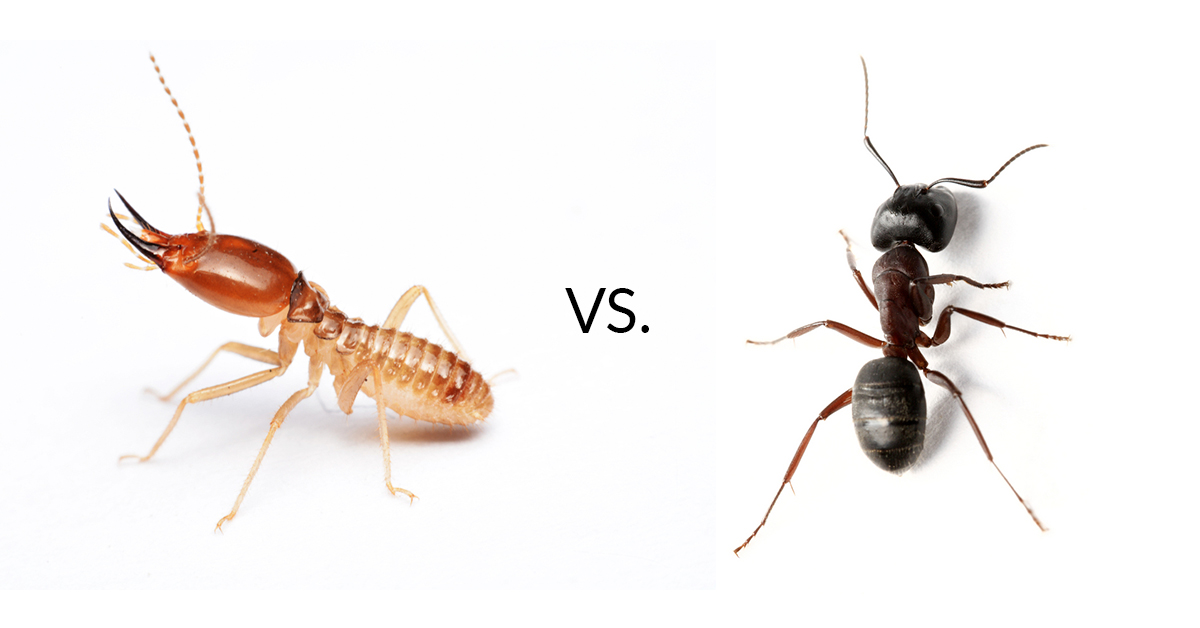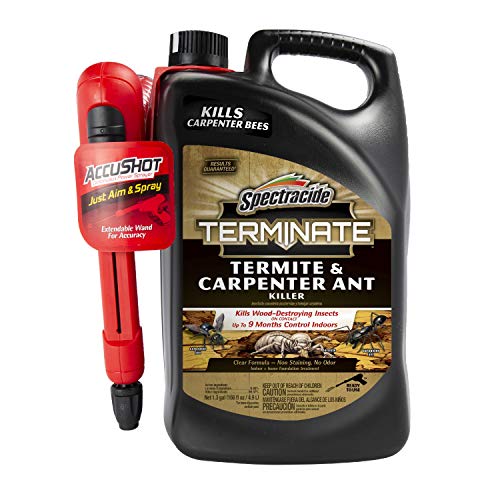Termites Versus Carpenter Ants
Termites actually eat wood. They love the cellulose in wood, wood products and paper products, and will chew directly into healthy wood. Carpenter ants chew through wood to create tunnels and nests without actually eating the wood itself. Instead they push out the chewed wood, creating piles of what looks like sawdust near the exterior of the entrances to their nests.
Carpenter ants have very neat nests and tunnels. The walls of their tunnels are very smooth whereas termite tunnels are rough, ragged and lined with soil. Carpenter ants also clean up their nests, removing leftover food, dead ant bodies, etc. They’re also known for collecting resin, which they use to disinfect their nests.
Termites generally live in the ground and create mud tubes to move back and forth between their nests and their food source (the wood in your home). Carpenter ants live in the wood they chew to make nests. Unlike other wood-chewing insects, such as termites, carpenter ants will build nests inside creosote-treated wood since they don’t ingest it. Generally, though, carpenter ants are attracted to wet or rotten wood because it’s easier to tunnel. Carpenter ants and termites can even chew through certain types of plastic. In fact, they regularly chew through PVC used in pool liners, filters, etc., costing homeowners a great deal of money.
Lastly, termites and carpenter ants are enemies who fiercely compete for the same type of environment and territory. Carpenter ants can actually kill and eat termites. In large enough numbers, carpenter ants can even destroy an entire termite colony.
Termites Versus Carpenter Ants
Introduction
Termite damage and carpenter ant damage have very similar characteristics. They both can lead to costly repairs if they are left untreated. It’s important to be able to tell the difference between these two problems so you can treat them properly before they cause further damage to your home.
What does termite damage look like?
Termites are tiny creatures that eat wood. They’re found in the soil around your home and can cause significant damage if left unchecked.
If you see termite damage, it may look like:
Termite tubes around your house or on the ground outside your home
Termite excavations in wood near windows, doors, porches and other areas where termites like to enter homes
Crumbling or missing mortar between bricks or stones on chimneys, patios, sidewalks or foundations
Termites and wood rot
Termites are one of the most common pests that can cause damage to your home. They can easily go undetected and cause significant damage in a short period of time. Termites will eat through the wood in your home, which causes problems with structural integrity and other safety issues. If any part of your house becomes damaged because of termites, it will need to be repaired or completely replaced.
Termite infestations are caused by the presence of these insects inside your property. These insects aren’t always visible, so you’ll have to look for signs that they’ve been there before finding them in person.
How to identify carpenter ant damage
Look for sawdust around the damaged area
Check for mounds of dirt, which may be hidden among mulch or under concrete slabs
Look for piles of wood shavings
Check damaged wood to see if small holes are present where carpenter ants have been tunneling in search of food or nesting sites; this type of damage can also be caused by termites but is more commonly seen in carpenter ants
If you spot small holes in your walls, check around them carefully as it’s likely that carpenter ants have started to build a nest inside your walls!
Both termites and carpenter ants can cause significant damage to your home.
Termites and carpenter ants can both be dangerous to your home. They cause damage by eating away at your furniture, door frames and even the walls of your house. Termites will eat their way through wood or other materials that are wet; this is why they’re a common problem with homes near water sources like lakes or rivers.
Carpenter ants are also known for chewing on wood structures but unlike termites, they only eat dead wood and therefore do not pose much risk for injury to people who live inside of houses or other buildings that have been infested with them (in most cases).
Conclusion
Many people are aware of the potential damage termites can cause to a home. However, some may not be aware that carpenter ants also pose a serious threat to your property—one which could end up costing you thousands of dollars if left untreated.
The biggest differences between these two types of pests is that termites feed on cellulose (the primary component in wood) while carpenter ants do not. Instead, they eat other insects and small pieces from decaying trees or branches. This means that the only way for them to destroy your house would be by chewing through the plasterboard walls or insulation materials found inside homes made with drywall construction techniques today so make sure you know what type of pest has been causing damage before deciding on how best to get rid of it!
We hope this guide was helpful in helping you identify both termite and carpenter ant infestations as well as finding treatment options for each type.”
- Attracts & Kills – Kills common household ants including acrobat, crazy, ghost, little black, odorous house, pavement, and other sweet-eating ants
- Kills the Ants You See & the Ones You Don’t – As worker ants discover the bait, they share it with the rest of the colony to eliminate them all
- Works Fast – You should see a significant decrease in the number of ants visiting the bait stations within just a few days
- Ready to Use – Place the bait stations, watch it attract ants, and eliminate the entire colony
- Use Throughout Your Home – Place stations near areas where you’ve seen ant activity including along baseboards, in corners, on counters, and more
Additional Info :
| Item Dimensions | |
| Height | 4.5 Inches |
| Width | 6.6 Inches |
| Length | 1.2 Inches |
| Weight | 0.27 Pounds |
- KILLS TERMITES AND CARPENTER ANTS: Indoor plus home foundation treatment against termites, carpenter ants, carpenter bees and other insects as listed.
- FOR INDOOR AND OUTDOOR USE: Up to 9 months control indoors
- KILLS CARPENTER BEES: Kills wood-destroying insects on contact.
- CLEAR FORMULA: Non-staining spray leaves no odor.
- ACCUSHOT SPRAYER: Continuous power sprayer for precise application.
Additional Info :
| Item Dimensions | |
| Height | 12.53 Inches |
| Width | 9.5 Inches |
| Length | 5.5 Inches |
| Weight | 12.25 Pounds |
- Kills Carpenter ants, termites, carpenter bees, wood wasps, and other insects
- Kills on contact and continues killing for up to 1 month
- 2 way spray nozzle allows you to reach crevices where pests live
- Odorless and non staining formula
- Ideal for indoor or outdoor use
Additional Info :
| Color | Orange |
| Item Dimensions | |
| Height | 9.4 Inches |
| Width | 8 Inches |
| Length | 2.7 Inches |
| Weight | 1.2 Pounds |
- Two termite products IN one: pop-up indicators detect termite activity, and the stakes kill foraging termites
- Installs IN minutes: place stakes in the ground 2 to 3 feet away from your home and no more than 10 feet apart
- Pop-up indicator: check the stakes for termite activity when the pop-up indicator is seen
- Complete kit: includes 15 stakes with locator shields, instruction booklet and digging tool
Additional Info :
| Item Dimensions | |
| Height | 16 Inches |
| Width | 12 Inches |
| Length | 4 Inches |
| Weight | 2 Pounds |
- Two types of bait to attract and kill ants
- After ants feed on the bait, they return to the colony and transfer the bait to other ants, thereby killing the entire colony
- Population reduction can be expected within days, with the baits working for up to 3 months
- For household use: Closets, basements, attics, living areas, kitchens, bathrooms, pantries, dining rooms, and recreation rooms
- Child-resistant
Additional Info :
| Color | Red |
| Item Dimensions | |
| Height | 5.01 Inches |
| Width | 5.62 Inches |
| Length | 1.1 Inches |
| Weight | 0.123 Pounds |
| Release Date | 2017-01-30T00:00:01Z |





